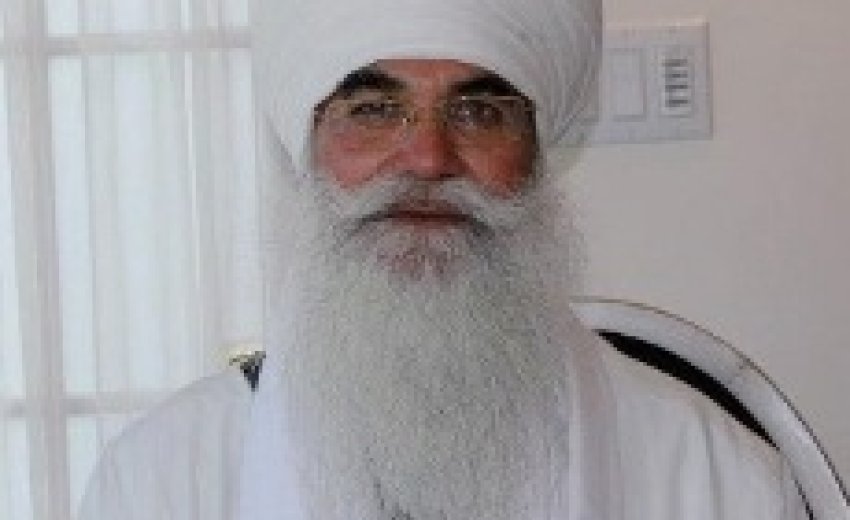On August 5, 2012, a gunman attacked the Sikh gurdwara in Oak Creek, Wisconsin, killing six sangat members and injuring several others. It was one of the worst hate crimes in recent American history. Baba Punjab Singh, a 65 year-old man, was critically injured during the attack and continues to require around-the-clock, long-term care at an inpatient rehabilitation center.
The following essay was written by Holly Sennett, a speech-language pathologist, who has been working with Baba Punjab Singh and his family since last fall. Holly shares Baba Punjab Singh’s heartwarming story and discusses how the tragic events of that day affected not only her life but all of our lives.
![]()
Written by: Holly Sennett | Released With Approval by: Raghuvinder Singh (Baba Punjab Singh’s son)
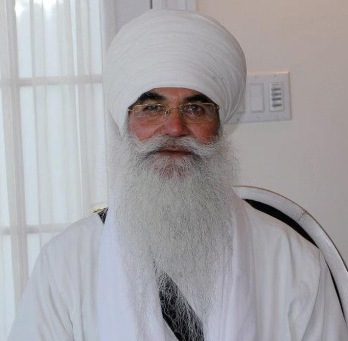 May 29, 2013: Sometimes our lives are blessed in ways that we could have never imagined. Sometimes our lives cross paths with special souls who possess golden hearts and who touch our own hearts in a manner that causes us to be transformed in both subtle and profound ways. Many of us have had the honor and privilege of meeting such individuals during our lifetime. I would like to share with you the story of a very special person.
May 29, 2013: Sometimes our lives are blessed in ways that we could have never imagined. Sometimes our lives cross paths with special souls who possess golden hearts and who touch our own hearts in a manner that causes us to be transformed in both subtle and profound ways. Many of us have had the honor and privilege of meeting such individuals during our lifetime. I would like to share with you the story of a very special person.
Punjab Singh is one of the Sikh religion’s most revered teachers. He has touched the lives of countless people throughout the world. His story is uniquely his own, however, the messages and lessons he continues to teach are timeless and encompass us all.
I am a speech-language pathologist who works in a facility that provides care for individuals recovering from a variety of medical diagnoses. The name of the facility is being kept confidential at this time to maintain Punjab Singh’s privacy during his rehabilitation process.
I was asked to collaborate with Punjab Singh’s eldest son, Raghuvinder Singh, and the rest of his family to tell you Punjab Singh’s story because he is a victim of a hate crime. His injury is severe and he is not able to voice his own story at this point. We are pleased to say that there have been unexpected improvements and progress that doctors initially never imagined would happen. There are many signs that point to hope for continued miracles to come with the support of prayers from all of those people around the world who are moved in their hearts to earnestly pray on his behalf for healing.
On August 5, 2012, a community of peace-filled people had come together to praise the Creator of all of life in their Gurdwara, a Sikh place of worship, in Oak Creek, Wisconsin. This community experienced a moment of heart-shattering darkness that, while frozen in time, continues to reverberate today.
On this day in August, a stranger with a blanket of hateful, fearful thoughts covering his mind entered into the Gurdwara (“gur”=Lord, “dwara”=door). Six people were killed and three others were wounded. Punjab Singh miraculously survived being shot in the head.
The Gurdwara is the “Lord’s Door” and, as Raghuvinder Singh explained, the Lord’s door is always open. It is a place where God is remembered and praised by members of the fifth largest religion in the world. It is a religion of 30 million beautiful souls who live their lives seeking God. They are the Sikh community. The word “Sikh” literally means seeker of truth.
They follow the teachings of Guru Nanak who more than 500 years ago taught the eternal message of God’s holy truth that we are one with the Creator and we are one with each other. It is the basis of the universal golden rule, and it is the foundation of many world religions. Sikhs do not just give voice to these sacred teachings, they also strive to live and embody these in their daily lives.
I clearly remember watching a news story on August 5th just hours after the Gurdwara shooting occurred. The individual being interviewed had just witnessed a soul-shattering, horrific crime and yet had the strength and the grace to stand in front of the probing eyes of the camera and speak of forgiveness. ‘How beautiful’, I thought, that here in the midst of chaos, attack and darkness, this individual could remember to view the situation from a higher perspective. This perspective is not one often seen as an initial response by someone who has been a witness to horror. To speak of the call to forgive is to show love and compassion and to realize that ultimately—no matter what happens—we are all still connected. We are all one.
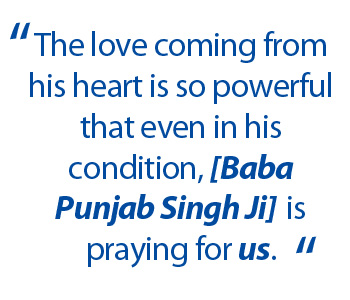 Punjab Singh traveled all over the world to share spiritual truths. He has taught about the oneness of all of life and the need to love and forgive. He was a visiting congregational leader on this August 5th day at the Oak Creek Gurdwara. Punjab Singh is not only a beloved leader, he is now a hospital patient. He is a treasure to all who have known him and his golden heart has impacted the lives of many through his teachings. This is true whether you knew Punjab Singh before or after the shooting.
Punjab Singh traveled all over the world to share spiritual truths. He has taught about the oneness of all of life and the need to love and forgive. He was a visiting congregational leader on this August 5th day at the Oak Creek Gurdwara. Punjab Singh is not only a beloved leader, he is now a hospital patient. He is a treasure to all who have known him and his golden heart has impacted the lives of many through his teachings. This is true whether you knew Punjab Singh before or after the shooting.
Many staff members at the hospital have had the great opportunity to hear stories about Punjab Singh’s life as told by his family and the community who loves him. His two sons from India now live their lives in dedication to being present to the care of their father. They alternate staying with him on a nearly 24-hour basis. Punjab Singh’s wife is here from India as well. The American culture is one that is foreign to her as she does not speak the language, and she finds it difficult to understand some of the styles of interaction between people in this country. Punjab Singh’s two daughters live in India and are sadly only able to visit occasionally. When family members are not at the hospital, they often stay with friends who were previously unbeknownst to them. These people generously opened up their home so that Punjab Singh’s family members would have a place to stay when they first arrived in the United States. Life becomes very strenuous when violence tears apart the fabric of the family and everyone’s life is now altered including extended family members. It is important to remember that we are all part of this extended family.
Raghuvinder Singh has shared numerous stories about his father. This has helped us understand his father’s gentle nature and his deep connection to the Creator of all of life. Punjab Singh would sometimes sit in meditation without moving an inch for up to 14 hours at a time. It is difficult for us to imagine doing something like this because we have busy, hectic lives and our minds are untrained and unfocused. Perhaps Punjab Singh was able to do this with ease because he was able to elevate his mind to a higher realm to commune with God in a place where time and space do not exist. Maybe 14 hours here on Earth seems like 20 minutes to a highly spiritually-developed individual. This is the level Punjab Singh had mastered.
While in meditation, Punjab Singh must have been in touch with an all-knowing view of the circumstances here on Earth. No matter where he was teaching in the world, he would call either of his sons by phone and tell them to go to certain homes in India. Punjab Singh would give instructions on what to take to the family in need. It might have been provisions or money. Often times, the sons were instructed to pay for school fees, school supplies and uniforms for needy families and orphans. The gift of education was a priority for Punjab Singh, and it was part of his life’s mission.
There is a pervasive sense of peace and calm when you enter Punjab Singh’s room at the hospital. There is sacred music playing continuously. It is the intoning and the chanting of the holy name for God in the Sikh religion—“Waheguru” (pronounced “Wah-hey-guru”). The meaning of this word is quite beautiful. “Wahe”=great, wonderful; “gu”=darkness; “ru”=illumination. It means the great and wonderful Lord who comes into the darkness to bring the light of illumination into the world. The parallel of this description of the essence of God in many other world religions is obvious.
On December 4, 2012, a session with a therapeutic harpist and a massage therapist who provided Healing Touch, which is a form of energy work done over the body without actually touching, was arranged. Some members of the Oak Creek Gurdwara and other hospital staff, administrators and nursing students were present.
None of the people in attendance could have imagined the powerful and effective nature of this alternative healing session. The harpist positioned her instrument at the foot of the bed while the massage therapist stood on Punjab Singh’s left side to provide restoration, balance and loving care. Miraculously, he began to move and track his eyes to the left side soon after this healing session. Previously, he was only able to move his eyes midline and to the right side. Punjab Singh has now shown ability to establish soul-connective eye contact in a right to left fashion when listening to stories told to him in English and then translated to him in his native Punjabi language by his sons. He can double blink his eyes in a deliberate fashion to indicate an affirmative response. When Punjab Singh is awake and alert, it is clear to all of his care-givers that he knows and he understands what is being said to him.
As the harpist played, harmonious tones filled the room as the gift of this elegant music went out like beautiful waves of healing sound. This gift was not only meant for Punjab Singh, but prayerful intentions for the healing of others in the hospital and for healing all over the world were created and visualized in the mind’s eye of the people who were present. Tears sprang to our physical eyes as well. This reflected how deeply the collective soul of those spiritually sensitive persons who had gathered was touched. Some of the comments heard were,
“I have never been in the presence of someone so holy in all of my life.”
“The love coming from his heart is so powerful that even in his condition, he is praying for us.”
These comments highlight the manner in which Punjab Singh continues to touch the lives of others. He is allowing us to learn about caring for life with the awareness of an added dimension of sacred reverence. When the opportunity arises, I try to give voice to this concept. I have talked to various staff members about what they are learning from Punjab Singh and that they need to carry this significant understanding deep within themselves so that they can provide the same level of reverent care to others. We should all provide reverent care to others no matter who we meet on our journey through life. It is evident that this beloved, holy man teaches us still.
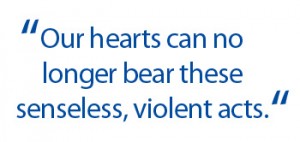 On December 14, 2012, another national and world tragedy manifested itself in Newtown, Connecticut. A gunman with a mind blanketed with the veil of dark, attacking and violent thoughts entered Sandy Hook Elementary School. Twenty precious and innocent six and seven year old students were killed along with six adults who gave their lives trying to shield them from evil.
On December 14, 2012, another national and world tragedy manifested itself in Newtown, Connecticut. A gunman with a mind blanketed with the veil of dark, attacking and violent thoughts entered Sandy Hook Elementary School. Twenty precious and innocent six and seven year old students were killed along with six adults who gave their lives trying to shield them from evil.
On this day our collective hearts were not only broken, they were completely shattered again. Punjab Singh’s eldest son, Raghuvinder Singh, had the T.V. on that day and he spoke to his father about yet another tragedy to befall our nation and our world. Tears fell from Punjab Singh’s eyes. His heart weeps for the loss of the innocent because unfortunately he knows all too well about the impact of violence. He lives each day with the devastating and limiting effects of it.
Punjab Singh’s progress is gradual as the neural pathways struggle to slowly regenerate so that he can recover more function to his body. Perhaps this is our path as well. We need a clear path to healing but none of us desires that this path be a slow and arduous process. We pray for a miraculous lightning bolt of healing to come rushing into our individual worlds and into our global world. We want a speedy fix for the pain and sorrow in our lives.
Our hearts can no longer bear these senseless, violent acts. Violence does not belong in our places of worship where we come to connect with the divine. Violence does not belong in our schools and universities where we go to learn to richly develop the individual gifts that we possess. Violence does not belong in our workplaces where we go to contribute to an organization and to make a living to support ourselves and our families. Violence does not belong in our shopping malls where we go to gather the needed items for our lives. Violence does not belong in our theaters where we go to be entertained. Violence does not belong at our sporting events where we come together in a spirit of unity. Violence does not belong in our homes that are supposed to be a safe haven and a refuge for us to enter into for nourishment and regeneration of our bodies and souls.
We all want a new direction and a new path. We see the pain in our daily news reports so often that we have almost become numb to it as a way to protect ourselves. We feel the pain in our hearts for a long, long time after the violence has touched our lives. We grope to understand. We ask many questions in a search for an answer to make sense of the intrusion of violence. We look outside ourselves and by the power of projection we point our fingers in many different directions because we want answers, and we want these answers now. We are sure that someone else or something else is the problem. We say that the violence that we see in the world is the result of many different factors.
We proclaim that it is the fault of the parent who raised the perpetrator. We say that our law enforcement system should have known and protected us better. We think putting up signs will help. We say it is the fault of the school system. Perhaps the principals, counselors and teachers should have identified the potential killer so that they could do a better job of protecting us.
It is none of these things. The violent action is a result of misguided thinking that has its basis steeped in repetitive, fearful thoughts. Many times these thoughts are due to a false story fabricated in the mind. The misguided individual did not take the time to educate themselves about a situation or another person. They did not take the time to listen with an open heart.
It is a rare individual that will ever turn that pointed, accusing finger that frantically looks out into the world searching for a reason for the pain they are experiencing back toward themselves. Perhaps we need to examine our own thinking and hold ourselves accountable. The only questions that we can ask and possibly have any chance of controlling are:
“What is my part?” and “What can I do myself to contribute to peace in this world?”
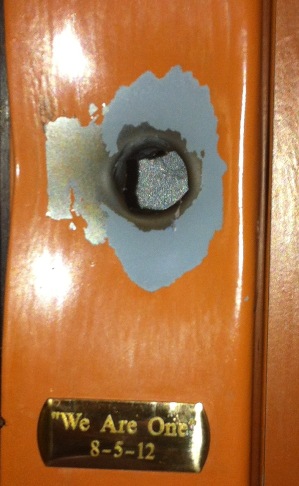 When we look within we realize that the thinking in our minds is the source of our problems. We cannot harbor attack thoughts toward ourselves, toward others and toward the world in which we live. We cannot think negative, fearful thoughts that harm. We cannot say words that hurt ourselves or others. There is great power in the words we choose and in our voices that deliver these words. We need to choose words that represent our best and highest potential. The effect on another person’s soul may not be outwardly seen but the impact of these words is deep and lasting. Words can shape who we believe we are. We cannot use our hands that were meant to work collaboratively together for angry, hurtful purposes. It is wrong. Many people all over the world agree with these statements. We have just forgotten how to manifest our best and highest selves.
When we look within we realize that the thinking in our minds is the source of our problems. We cannot harbor attack thoughts toward ourselves, toward others and toward the world in which we live. We cannot think negative, fearful thoughts that harm. We cannot say words that hurt ourselves or others. There is great power in the words we choose and in our voices that deliver these words. We need to choose words that represent our best and highest potential. The effect on another person’s soul may not be outwardly seen but the impact of these words is deep and lasting. Words can shape who we believe we are. We cannot use our hands that were meant to work collaboratively together for angry, hurtful purposes. It is wrong. Many people all over the world agree with these statements. We have just forgotten how to manifest our best and highest selves.
How can we learn these important lessons and teach them to others? How can we help ourselves and others remember how unique and precious everyone is and how to value the work that we do with our hands? How can we affirm our belief that at a core level we are all one and we are connected with a higher power and with each other?
One way to help us remember is to focus on a key word or phrase that we want to keep forefront in our minds. We can use visual symbols to help. At the Gurdwara in Oak Creek, Wisconsin, there is a bullet hole in a metal doorpost to the sanctuary. The Sikh community has decided not to repair the doorpost but instead to leave the hole as a reminder. Astonishingly, a golden plate is posted below this bullet hole of violence with the words, “We Are One” engraved upon it. The message articulates the highest form of response to violence—forgiveness. Even though violence came through the Lord’s door, a reminder of God’s sacred message to us is posted there. It signifies that no matter what, we all need to look past the circumstances—no matter how grave—and try to see from a higher perspective that we are all one. If our hearts are connected then we will realize that despite our external differences we are all the same.
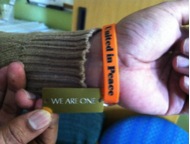 The Oak Creek Gurdwara has created orange silicone wristbands with the message, “United in Peace” that they distribute to people in the congregation and to anyone who visits. These serve as a reminder of this important message. It would be wonderful if everyone in the world knew the story and had a wristband to wear, but this is not possible. Other reminders have been created using pet tags and key chain tags engraved with the messages of “Peace” and “Oneness” as objects to hold or wear. When the shooting in Connecticut left a deep scar on our already broken hearts, a key chain tag with the message, “Connect Our Hearts in Peace” was made with the date of the shooting engraved on the back. These precious souls will not be forgotten.
The Oak Creek Gurdwara has created orange silicone wristbands with the message, “United in Peace” that they distribute to people in the congregation and to anyone who visits. These serve as a reminder of this important message. It would be wonderful if everyone in the world knew the story and had a wristband to wear, but this is not possible. Other reminders have been created using pet tags and key chain tags engraved with the messages of “Peace” and “Oneness” as objects to hold or wear. When the shooting in Connecticut left a deep scar on our already broken hearts, a key chain tag with the message, “Connect Our Hearts in Peace” was made with the date of the shooting engraved on the back. These precious souls will not be forgotten.
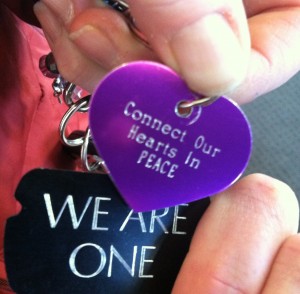 It is our hope that all people who read this story with an open heart will act upon the impulse to stop by their local pet store or locksmith and have a key chain tag engraved. Any form of the messages that are the greatest hopes of this world could be made permanently visible. All it would then take is a few seconds to focus the eyes and the mind on the messages of “Oneness” and “Peace” and repeat them silently in our minds or out loud several times each day. What an easy way to create a visual reminder that could create a new world.
It is our hope that all people who read this story with an open heart will act upon the impulse to stop by their local pet store or locksmith and have a key chain tag engraved. Any form of the messages that are the greatest hopes of this world could be made permanently visible. All it would then take is a few seconds to focus the eyes and the mind on the messages of “Oneness” and “Peace” and repeat them silently in our minds or out loud several times each day. What an easy way to create a visual reminder that could create a new world.
Perhaps this might be the beginning of the needed change in our hearts and minds. Perhaps it will start a new movement that could literally change the world we see. We could all band together and smile in nodded acknowledgement every time we notice someone else with the same message on their key chain tags. We would understand that no matter where we live in this world our hearts have the same prayer and intention for healing. It is time to remember…


